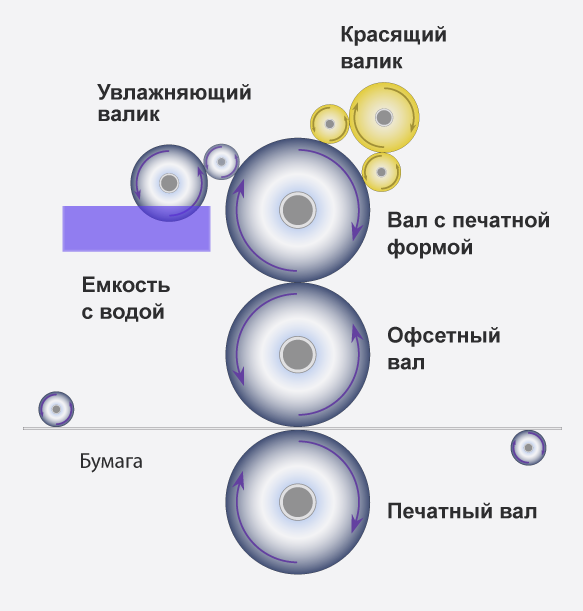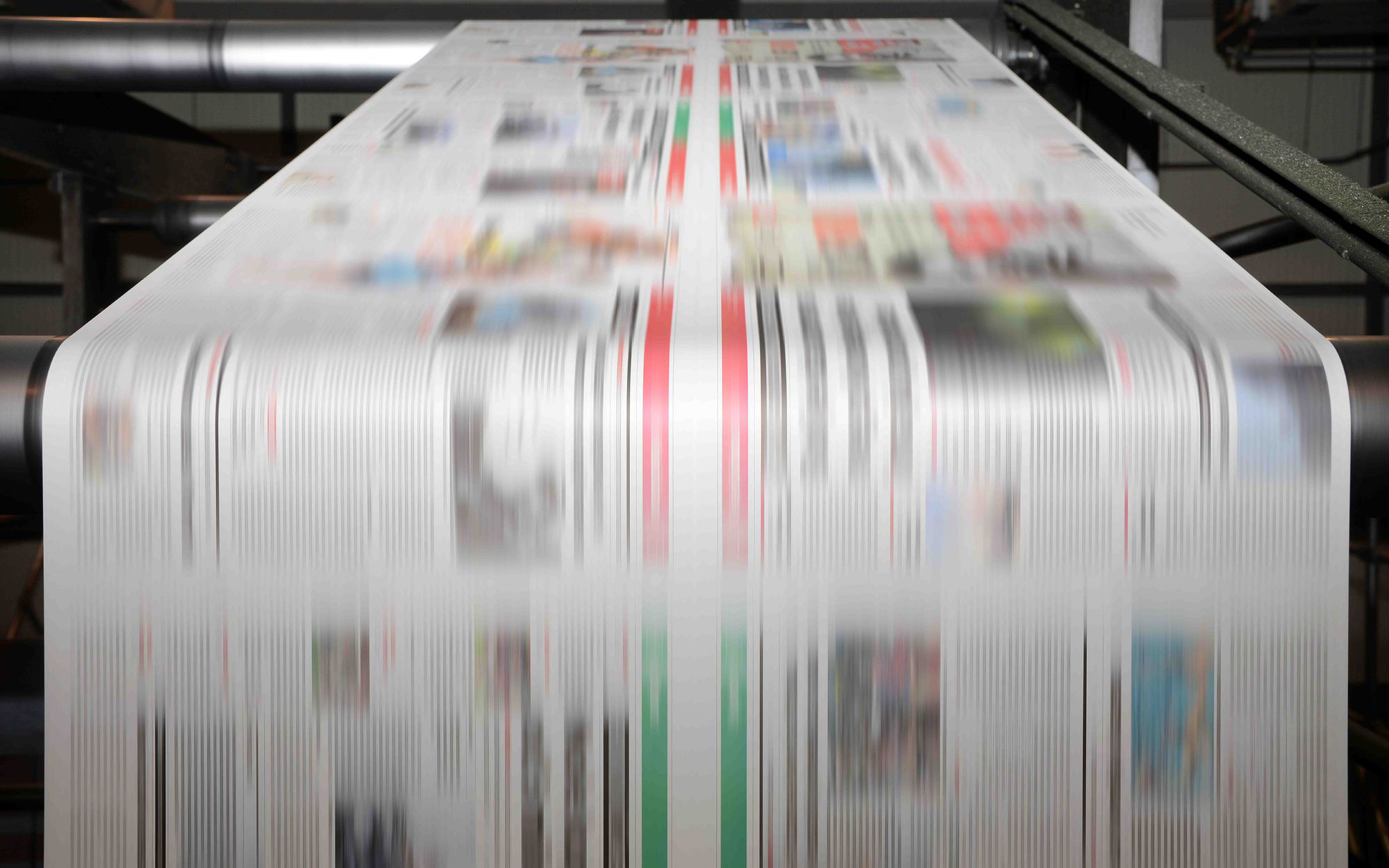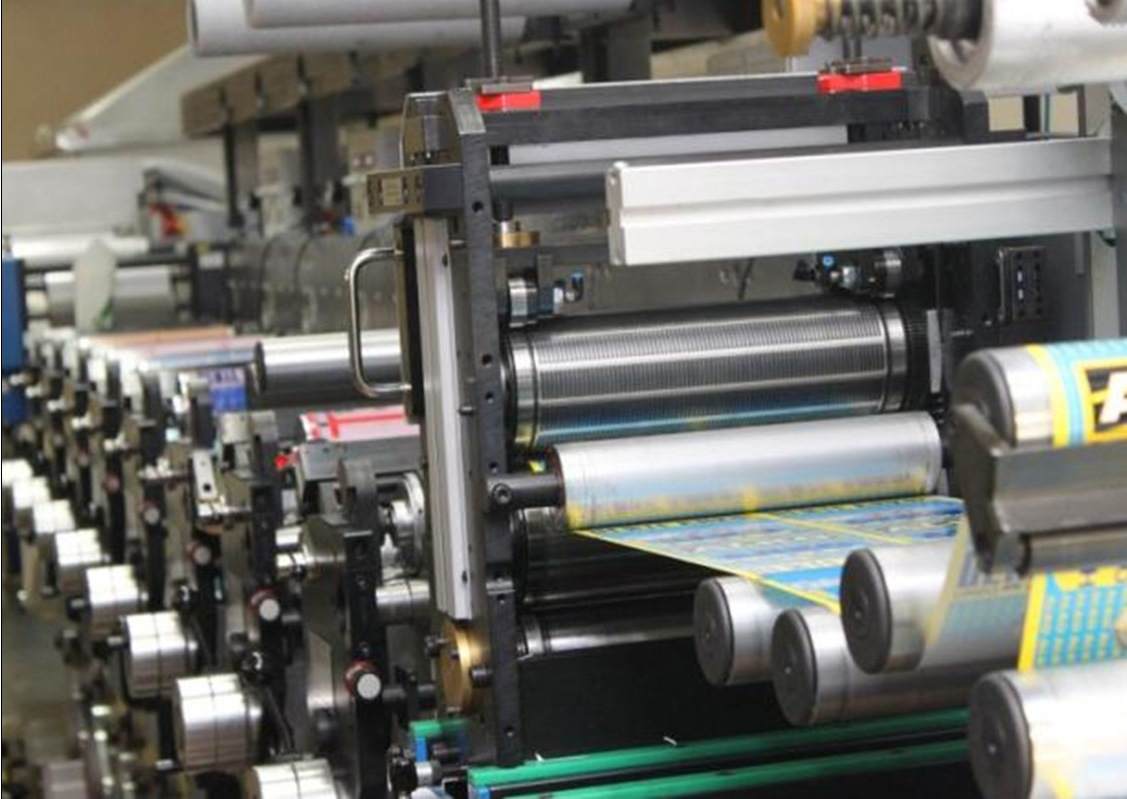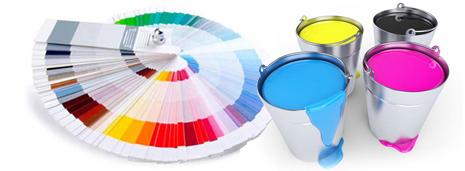
Offset printing (in printing, Engl. offset – without contact with the printing form) is a printing technology, which provides for the transfer of ink from the printing plate to the printed material indirectly, and through an intermediate offset cylinder. Accordingly, unlike other printing methods, the image on the printed form is not mirrored, but straight. Offset is mainly used in flat printing.
Color scheme (click to enlarge)

Operating principle
Printing
In traditional offset printing, the ink is applied to the paper by passing through at least two rolls: one is called the plate roll and the other is called the offset roll. The form is most often a plate with a photosensitive coating. Usually aluminum alloys serve as the basis for the plate. Earlier, as a rule, coated cardboard was used.
Then the image is applied to the form. After exposure and development, the exposed parts of the form begin to attract water and repel any oily substance, in particular ink. Such parts are called hydrophilic and (rarely) oleophobic. Remaining (non-highlighted) parts of shapes, on the contrary, begin to repel water and attract paint. They, in turn, are called hydrophobic or oleophilic. Thus the paint is transferred exclusively to the hydrophobic parts of the form, forming letters and images. At every turn with the damping roller system the shaft with the printing plate is washed with water, then ink is applied to its hydrophobic parts through a system of ink rollers. The image is transferred from the shaft with a printing form to the offset shaft, and from the offset shaft to the paper. Offset printing contributes to less mold wearout and greater ink evenness.
Transferring an image to a printing plate
 There are several technologies for transferring an image to a printing plate. Among them, there is a computer-to-plate or CTP technology, which transfers the image directly to the printed form using a platesetter. In traditional printing, the image is transferred from photoplates, which, in turn, can be produced digitally, using technology
computer-to-film or CTF, or manually using photoset.
There are several technologies for transferring an image to a printing plate. Among them, there is a computer-to-plate or CTP technology, which transfers the image directly to the printed form using a platesetter. In traditional printing, the image is transferred from photoplates, which, in turn, can be produced digitally, using technology
computer-to-film or CTF, or manually using photoset.
Advantages of offset printing:
- The best print quality.
- Ability to print on any type of paper and use of any type of postpress
processing.
- Long-run printing in short terms.
- Significant cost reduction for long-run printing.
Disadvantages of offset printing:
- Offset printing requires prepress processing (color separation, color proofing, plates manufacturing, printing press setup, color balancing),
which makes it impossible to fulfill urgent orders, for example, in an hour.
- Prepress and setup increase costs, and short runs may not be profitable.
- Personalization of data during offset printing is impossible, although this disadvantage is easily compensated for by post-press processing, for example, an additional run
on a digital printing machine.
Color Images Printing
 Using the technology described above, you can get an image of only one color used in color rollers. There are several ways to print color images, of which the two most common should be mentioned. This is printing in several runs and printing on a multicolor printing machine. Both of these methods are based on the decomposition
any color across multiple color components, such as CMYK. For each page of color
image, a set of printing plates is made, the images on which correspond to the color component of the image in the CMYK system. These plates are either installed
alternately into a machine with one set of shafts, or simultaneously into a machine with several sets of shafts. In the first case, the printing of one color component is called a “run”. Machines with several sets of shafts are called multicolor. The most common types of multi-color machines have their own names: two-color, three-color and so on. Control systems based on densitometry, colorimetry, and color proof are used to ensure accurate color reproduction in printing.
Using the technology described above, you can get an image of only one color used in color rollers. There are several ways to print color images, of which the two most common should be mentioned. This is printing in several runs and printing on a multicolor printing machine. Both of these methods are based on the decomposition
any color across multiple color components, such as CMYK. For each page of color
image, a set of printing plates is made, the images on which correspond to the color component of the image in the CMYK system. These plates are either installed
alternately into a machine with one set of shafts, or simultaneously into a machine with several sets of shafts. In the first case, the printing of one color component is called a “run”. Machines with several sets of shafts are called multicolor. The most common types of multi-color machines have their own names: two-color, three-color and so on. Control systems based on densitometry, colorimetry, and color proof are used to ensure accurate color reproduction in printing.
Types of offset printing and development
The most modern type of offset printing is digital offset. With this technology, the image is applied to the printing plate, directly installed in the machine. The traditional technology using photoplates is now called photo offset. In addition, there is a classification by types of materials - sheet-fed and web offset (rotation). Web offset presses do not use single sheets of paper, but huge rolls of paper.
It should be noted that offset printing is considered more profitable for long-run printing. Digital print is used almost everywhere for short-run printing.

